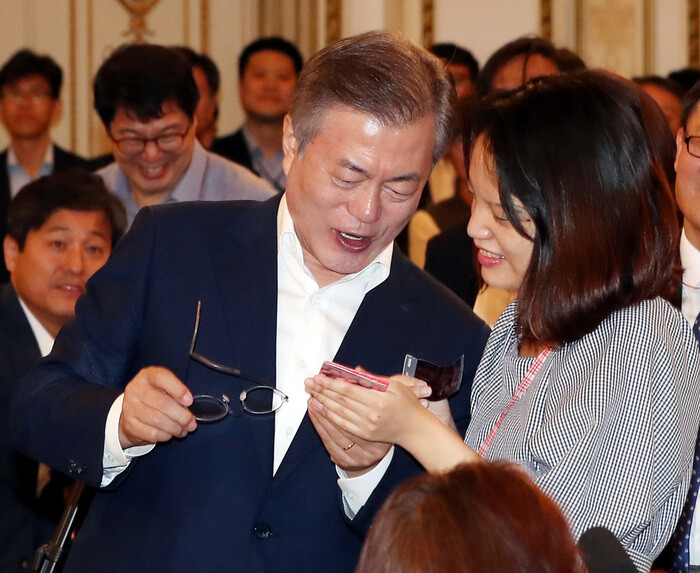hankyoreh
Links to other country sites 다른 나라 사이트 링크
[Editorial] The importance of state support for developmentally disabled persons

Family members of people with developmental disabilities have long taken to the streets to fight disregard from South Korea’s state and society. They have kneeled on the ground for the building of special schools and tearfully shaved their heads to demand introduction of a state responsibility system.
The government’s announcement of a “comprehensive plan based on the life cycle of a developmentally disabled person” at the Blue House State Reception House on Sept. 12 – with President Moon Jae-in in attendance alongside a number of individuals with developmental disabilities – is significant as the state’s first-ever response to these earnest voices.
Due to their cognitive and communicative impairments, developmentally disabled people are seen as facing particular difficulties achieving self-sufficiency. Not only are public education institutions utterly inadequate, but many find themselves with nowhere to go once they reach adulthood. The employment rate for all people with disabilities is 36 percent; for those with developmental disabilities, it is a much lower 23 percent.
This is to say nothing of the harsh situation facing disabled persons living in South Korea’s provinces. Most families either flee overseas to avoid discrimination or, if that is not an option, live a long, tearful life hoping against hope that they don’t post too much a burden on their families.
The measures pledged by the government according to the developmentally disabled person’s life cycle include expansions of the targets of medical examination support; increased childcare and education facilities; increased special schools and staffing; local community participation and improved independence; and stronger caregiving infrastructure.
While the number of targets (1,500 in 2019) is still very small compared to the total number of developmentally disabled people (226,000 overall, 170,000 of them adults), the institution of daily activity services according to the Development Disability Act enacted four years ago is also drawing attention.
South Korea’s policies for disabled people are facing a major transformation. From July 2019, the current disability level system – which classifies disabled people into six levels for standardized services – is set to be abolished. But as suggested by the recent voices of criticism and worry over the general questionnaire that will be taking the system’s place, disabled people could end up forced into a battle for their “share of the pie” without a firm commitment from the administration – and the historic budget increase needed to honor it.
As we’ve seen with the difficulties establishing a special school in Seoul’s Gangseo district, this is not something the government can achieve on its own without a general change in societal attitudes. Rather than continuing to view disabled people as targets for welfare-based charity, both the state and society need to start seeing them as people whose rights as people should not be restricted simply because of their disabilities.
Please direct comments or questions to [english@hani.co.kr]

Editorial・opinion
![[Guest essay] The real reason Korea’s new right wants to dub Rhee a founding father [Guest essay] The real reason Korea’s new right wants to dub Rhee a founding father](https://flexible.img.hani.co.kr/flexible/normal/500/300/imgdb/original/2024/0423/8317138574257878.jpg) [Guest essay] The real reason Korea’s new right wants to dub Rhee a founding father
[Guest essay] The real reason Korea’s new right wants to dub Rhee a founding father![[Column] ‘Choson’: Is it time we start referring to N. Korea in its own terms? [Column] ‘Choson’: Is it time we start referring to N. Korea in its own terms?](https://flexible.img.hani.co.kr/flexible/normal/500/300/imgdb/original/2024/0423/3617138579390322.jpg) [Column] ‘Choson’: Is it time we start referring to N. Korea in its own terms?
[Column] ‘Choson’: Is it time we start referring to N. Korea in its own terms?- [Editorial] Japan’s rewriting of history with Korea has gone too far
- [Column] The president’s questionable capacity for dialogue
- [Column] Are chaebol firms just pizza pies for families to divvy up as they please?
- [Column] Has Korea, too, crossed the Rubicon on China?
- [Correspondent’s column] In Japan’s alliance with US, echoes of its past alliances with UK
- [Editorial] Does Yoon think the Korean public is wrong?
- [Editorial] As it bolsters its alliance with US, Japan must be accountable for past
- [Guest essay] Amending the Constitution is Yoon’s key to leaving office in public’s good graces
Most viewed articles
- 1[Column] ‘Choson’: Is it time we start referring to N. Korea in its own terms?
- 2Why Korea shouldn’t welcome Japan’s newly beefed up defense cooperation with US
- 3Senior doctors cut hours, prepare to resign as government refuses to scrap medical reform plan
- 4[Guest essay] The real reason Korea’s new right wants to dub Rhee a founding father
- 5Opposition calls Yoon’s chief of staff appointment a ‘slap in the face’
- 6[Column] The clock is ticking for Korea’s first lady
- 7Terry Anderson, AP reporter who informed world of massacre in Gwangju, dies at 76
- 8New AI-based translation tools make their way into everyday life in Korea
- 9Samsung barricades office as unionized workers strike for better conditions
- 10Korea ranks among 10 countries going backward on coal power, report shows